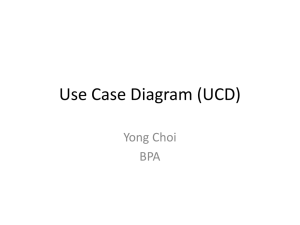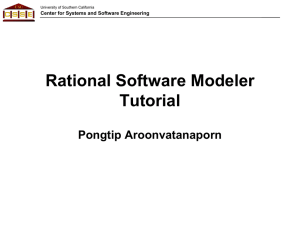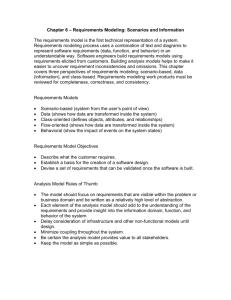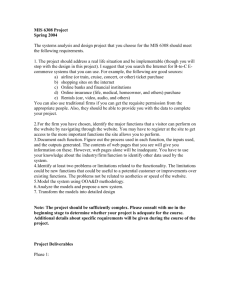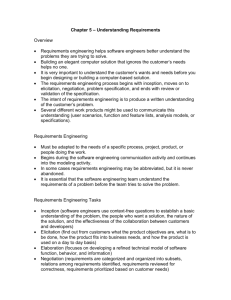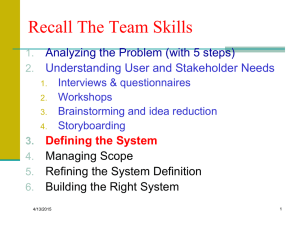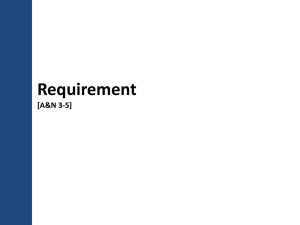Use case
advertisement
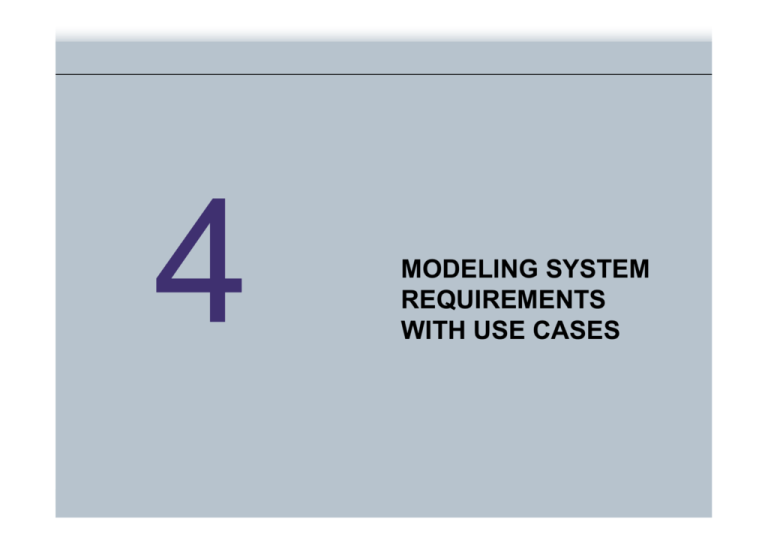
MODELING SYSTEM REQUIREMENTS WITH USE CASES Learning Objectives • Describe the benefits of use-case modeling. • Define actors and use cases and be able to identify them from context diagrams and other sources. • Describe the relationships that can appear on a use-case model diagram. • Describe the steps for preparing a use-case model. • Describe how to construct a use-case model diagram. • Describe the various sections of a use-case narrative and be able to prepare one. • Define the purpose of the use-case ranking and priority matrix and the use-case dependency diagram. Chapter Map An Introduction to Use-Case Modeling • One of the primary challenges in a system design process is the ability to elicit the correct and necessary system requirements from the stakeholders and specify them in a manner understandable to them so those requirements can be verified and validated. – Data and process models, prototypes, requirement specifications. – Understood by designers but not by users. – Leads to scope creep, schedule creep, cost overruns. The hardest single part of building a software system is deciding precisely what to build. No other part of the conceptual work is a difficult as establishing the detailed technical requirements, including all the interfaces to people, to machines, and to other software systems. No other work so cripples the resulting system if done wrong. No other part is more difficult to rectify later. Fred Brooks IS Development Project Track Record canceled before completion Over budget, late, or without needed features Source: The Standish Group International, Inc., “Chaos: A Recipe for Success” User-Centered Development and Use-Case Modeling User-centered development – a process of systems development based on understanding the needs of the stakeholders and the reasons why the system should be developed. Use-case modeling – the process of modeling a system’s functions in terms of business events, who initiated the events, and how the system responds to those events. – Use-case modeling has roots in object-oriented modeling. – Gained popularity in nonobject development environments because of its usefulness in communicating with users. – Compliments traditional modeling tools. Benefits of Use-Case Modeling • Provides a tool for capturing functional requirements. • Assists in decomposing system scope into more manageable pieces. • Provides a means of communicating with users and other stakeholders concerning system functionality in a language that is easily understood. • Provides a means of identifying, assigning, tracking, controlling, and management system development activities, especially incremental and iterative development. • Provides an aid in estimating project scope, effort, and schedule. • Provides a baseline for testing in terms of defining test plans and test cases. • Provides a baseline for user help systems and manuals as well as system development documentation. • Provides a tool for requirements traceability. • Provides a starting point for the identification of data objects or entities. • Provides functional specifications for designing user and system interfaces. • Provides a means of defining database access requirements. • Provides a framework for driving the system development project. System Concepts for Use-Case Modeling Use-case diagram – a diagram that depicts the interactions between the system and external systems and users. – It graphically describes who will use the system and in what ways the user expects to interact with the system. Use-case narrative – a textual description of the business even and how the user will interact with the system to accomplish the task. Use case – a behaviorally related sequence of steps (a scenario), both automated and manual, for the purpose of completing a single business task. – Description of system functions from the perspective of external users in terminology they understand. Sample Use-Case Model Diagram Basic Use-Case Symbols Use case – subset of the overall system functionality – Represented graphically by a horizontal ellipse with the name of the use case appearing above, below, or inside the ellipse. Actor – anything that needs to interact with the system to exchange information. – Could be a human, an organization, another information system, an external device, or even time. Temporal event – a system event triggered by time. – The actor is time. Four Types of Actors • Primary business actor – The stakeholder that primarily benefits from the execution of the use case. – e.g. the employee receiving the paycheck • Primary system actor – The stakeholder that directly interfaces with the system to initiate or trigger the business or system event. – e.g. the bank teller entering deposit information • External server actor – The stakeholder that responds to a request from the use case. – e.g. the credit bureau authorizing a credit card charge • External receiver actor – The stakeholder that is not the primary actor but receives something of value from the use case. – e.g. the warehouse receiving a packing slip Use Case Association Relationship Association – a relationship between an actor and a use case in which an interaction occurs between them. – Association modeled as a solid line connecting the actor and the use case. – Association with an arrowhead touching the use case indicates that the use case was initiated by the actor. – Association lacking arrowhead indicates a receiver actor. – Associations may be bidirectional or unidirectional. Use Case Extends Relationship Extension use case – a use case consisting of steps extracted from a more complex use case in order to simplify the original case and thus extend its functionality. – Relationship between the extension use case and the use case it is extending is called an extends relationship. – Represented as an arrowheaded line beginning at the extension use case and point to the use case it is extending. – Each extends relationship line is labeled “<<extends>>.” Use Case Uses Relationship Abstract use case – a use case that reduces redundancy among two or more other use cases by combining the common steps found in those cases. – An abstract case is available for use by any other use case that requires its functionality. – Relationship between the abstract use case and the use case that uses it is called a uses (or includes) relationship. – Depicted as an arrowheaded line beginning at the original use case and pointing to the use case it is using. – Each uses relationship line is labeled “<<uses>>.” Use Case Depends On Relationship Depends On – a use case relationship that specifies which other use cases must be performed before the current use case. – Can help determine sequence in which use cases need to be developed. – Depicted as an arrowheaded line beginning at one use case and pointing to a use case it is dependent on. – Each depends on relationship line is labeled “<<depends on>>.” Use Case Inheritance Relationship Inheritance – a use case relationship in which the common behavior of two actors initiating the same use case is extrapolated and assigned to a new abstract actor to reduce redundancy. – Other actors can inherit the interactions of the abstract actor. – Depicted as an arrowheaded line beginning at one actor and pointing to the abstract actor whose interactions the first actor inherits. The Process of Requirements Use-Case Modeling • Objective is to elicit and analyze enough requirements information to prepare a model that: – Communicates what is required from a user perspective. – Is free of specific details about how the system will be built or implemented. • • To effectively estimate and schedule project, may need to include preliminary “system implementation assumptions.” Steps 1. 2. 3. 4. Identify business actors. Identify business use cases. Construct use-case model diagram. Documents business requirements use-case narratives. Step 1: identify Business Actors • When looking for actors, ask the following questions: – – – – Who or what provides inputs to the system? Who or what receives outputs from the system? Are interfaces required to other systems? Are there events that are automatically triggered at a predetermined time? – Who will maintain information in the system? Sample List of Actors Step 2: Identify Business Requirements Use Cases • During requirements analysis, strive to identify and document only the most critical, complex, and important use cases, often called essential use cases. • When looking for use cases, ask the following questions: – What are the main tasks of the actor? – What information does the actor need form the system? – What information does the actor provide to the system? – Does the system need to inform the actor of any changes or events that have occurred? – Does the actor need to inform the system of any changes or events that have occurred? Sample Context Diagram Sample Use-Case Glossary continued Sample Use-Case Glossary (continued) continued Sample Use-Case Glossary (concluded) Step 3: Construct Use-Case Model Diagram Step 4: Document Business Requirements Use-Case Narratives • Document first at high level to quickly obtain an understanding of the events and magnitude of the system. • Then expand to a fully-documented business requirement narrative. – Include the use case’s typical course of events and its alternate courses. Sample High-Level Version of a Use-Case Narrative Sample Expanded Version of a Use-Case Narrative continued Sample Expanded Version of a Use-Case Narrative (cont) continued Sample Expanded Version of a Use-Case Narrative (cont) Use Cases and Project Management • Use-case model can drive the entire development effort. • Project manager or systems analyst uses business requirements use cases to plan (estimate and schedule) the build cycles of the project. – Build cycles are scoped on the basis of the importance of the use case and the time it takes to implement the use case. • To determine importance of the use cases, will create: – Use-case ranking and evaluation matrix – Use-case dependency diagram Use-Case Ranking and Priority Matrix • In most projects, the most important use cases are developed first. Use-case ranking and priority matrix – a tool used to evaluate use cases and determine their priority. – Evaluates use cases on a scale of 1 to 5 against six criteria. 1. 2. 3. 4. 5. 6. Significant impact on the architectural design. Easy to implement but contains significant functionality. Includes risky, time-critical, or complex functions. Involves significant research or new or risky technology. Includes primary business functions. Will increase revenue or decrease costs. Sample Use-Case Ranking and Priority Matrix Use-Case Dependency Diagram Use-case dependency diagram – a graphical depiction of the dependencies among use cases. – Provides the following benefits: • Graphical depiction of the system’s events and their states enhances understanding of system functionality. • Helps identify missing use cases. • Helps facilitate project management by depicting which use cases are more critical. Sample Use-Case Dependency Diagram Latihan Saudara sebagai pengguna (user) Sistem Informasi KRS online FTI (disingkat Sistem KRS Online): – Identifikasi aktor-aktor yang terlibat dalam Sistem KRS Online – Identifikasi use-case yang terlibat dalam Sistem KRS Online – Buat Use-case Diagram
